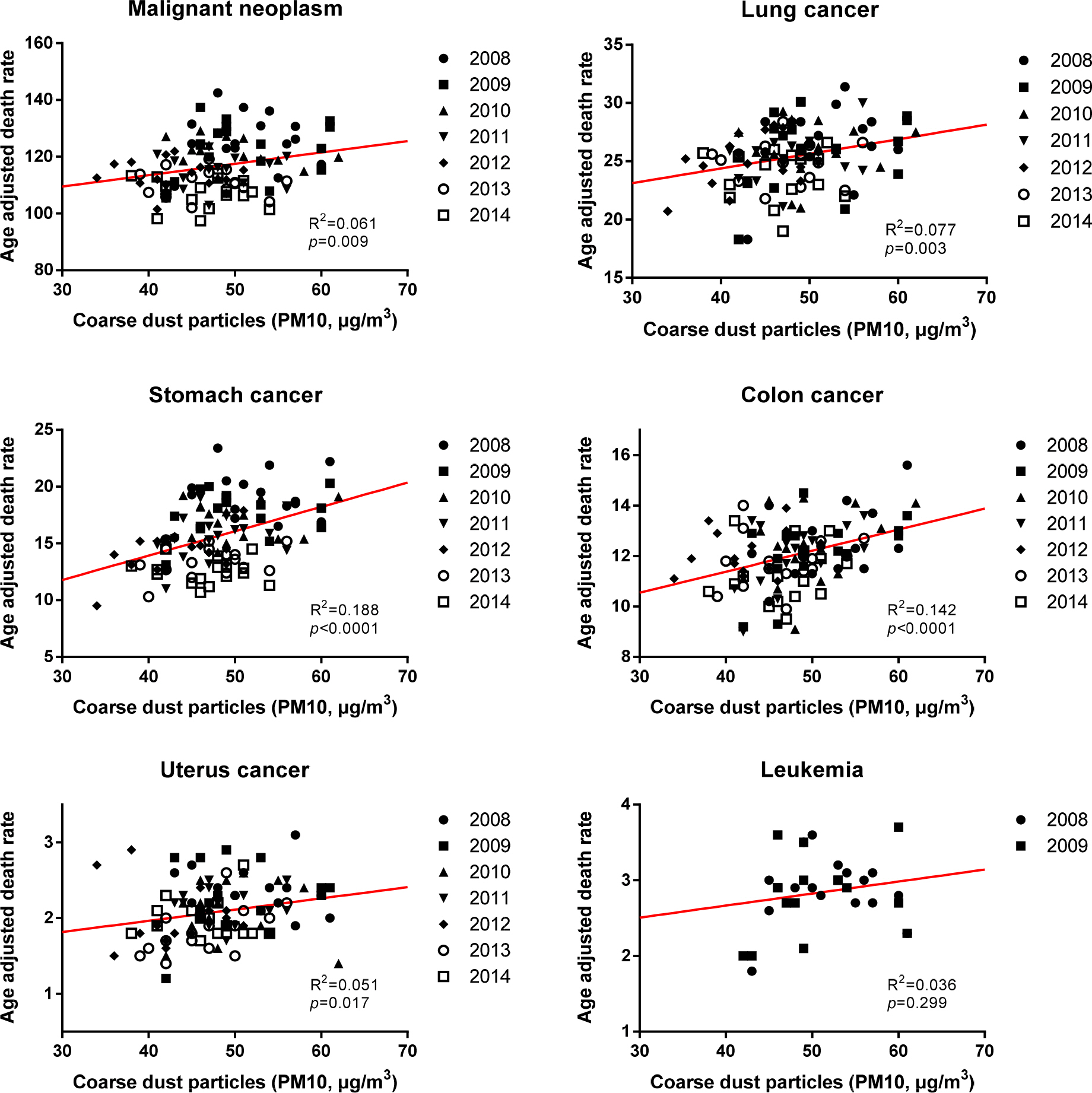Korean J Health Promot.
2016 Dec;16(4):215-222. 10.15384/kjhp.2016.16.4.215.
Correlation between Coarse Airborne Particulate Matter and Mortality Rates of Malignant Neoplasm
- Affiliations
-
- 1Department of Family Medicine, BHS Hanseo Hospital, Busan, Korea. kjh77960@hanmail.net
- KMID: 2367354
- DOI: http://doi.org/10.15384/kjhp.2016.16.4.215
Abstract
- BACKGROUND
There have been growing interests in harmful effects of dust particles on human health. It has been reported that dust particles negatively affected respiratory and cardiovascular systems. Relationship of dust particles and lung cancer incidence was also investigated. However, there is a lack of studies regarding the relationship between dust particles and cancers except for lung cancer. Therefore, this study aimed to determine the relationship of dust particle concentration and cancer mortality in Korea.
METHODS
Average concentration of coarse dust particles (particulate matter 10, PMâ‚â‚€) of 2008-2014 were obtained from AirKorea website and cancer mortality was found in Statistics Korea for 2008-2014. Correlation analyses using PMâ‚â‚€ and cancer mortality were performed. Age-adjusted death rate (AADR) was used for correlation analysis because a number of death and mortality rate do not reflect population and age of death. Regional annual PMâ‚â‚€ was matched with AADR of identical area. Correlation between two variables was presented in scatter plots and Pearson's correlation analysis was performed.
RESULTS
PMâ‚â‚€ concentration was positively correlated with AADR of malignant neoplasm, lung cancer, stomach cancer, colon cancer, uterus cancer, and leukemia. PMâ‚â‚€ concentration was significantly correlated with AADR of malignant neoplasm (r=0.247, P=0.009), lung cancer (r=0.277, P=0.003), stomach cancer (r=0.434, P=0.000), colon cancer (r=0.377, P=0.000), and uterus cancer (r=0.226, P=0.017).
CONCLUSION
This study suggested that cancer patients or high-risk group for cancer should pay attention to PMâ‚â‚€ concentration. Large-scale studies should investigate the relationship of PM10 concentration and cancer incidence including cancer mortality to extend understanding of this cross-section study.
MeSH Terms
Figure
Reference
-
References
1. International Agency for Research on Cancer. IARC Monographs on the Evaluation of Carcinogenic Risks to Humans: Outdoor Air Pollution. Lyon: International Agency for Research on Cancer;2014.2. World Health Organization. WHO's Ambient Air Pollution database: Update 2014. Geneva: World Health Organization;2014.3. Hsu A, Emerson J, Levy M, de Sherbinin A, Johnson L, Malik O, et al. The 2014 environmental performance index. New Haven: Yale Center for Environmental Law and Policy;2014. p. 4701–35.4. Ristovski ZD, Miljevic B, Surawski NC, Morawska L, Fong KM, Goh F, et al. Respiratory health effects of diesel particulate matter. Respirology. 2012; 17(2):201–12.
Article5. Dockery DW, Pope CA 3rd. Acute respiratory effects of particulate air pollution. Annu Rev Pub Health. 1994; 15:107–132.6. Schwartz J. What are people dying of on high air pollution days? Environ Res. 1994; 64(1):26–35.
Article7. Katsouyanni K, Touloumi G, Spix C, Schwartz J, Balducci F, Medina S, et al. Short-term effects of ambient Sulphur dioxide and particulate matter on mortality in 12 European cities: results from time series data from the APHEA project. Air Pollution and Health: a European Approach. BMJ. 1997; 314(7095):1658–63.8. Bateson TF, Schwartz J. Who is sensitive to the effects of particulate air pollution on mortality? A case-crossover analysis of effect modifiers. Epidemiology. 2004; 15(2):143–9.9. Kwon HJ, Cho SH, Nyberg F, Pershagen G. Effects of ambient air pollution on daily mortality in a cohort of patients with congestive heart failure. Epidemiology. 2001; 12(4):413–9.
Article10. Hystad P, Demers PA, Johnson KC, Carpiano RM, Brauer M. Long-term residential exposure to air pollution and lung cancer risk. Epidemiology. 2013; 24(5):762–72.
Article11. She J, Yang P, Hong Q, Bai C. Lung cancer in China: challenges and interventions. Chest. 2013; 143(4):1117–26.12. Evans J, van Donkelaar A, Martin RV, Burnett R, Rainham DG, Birkett NJ, et al. Estimates of global mortality attributable to particulate air pollution using satellite imagery. Environ Res. 2013; 120:33–42.
Article13. Salvador P, Artiñano B, Querol X, Alastuey A. A combined analysis of backward trajectories and aerosol chemistry to characterise long-range transport episodes of particulate matter: the Madrid air basin, a case study. Sci Total Environ. 2008; 390(2–3):495–506.
Article14. Raaschou-Nielsen O, Andersen ZJ, Beelen R, Samoli E, Stafoggia M, Weinmayr G, et al. Air pollution and lung cancer incidence in 17 European cohorts: prospective analyses from the European Study of Cohorts for Air Pollution Effects (ESCAPE). Lancet Oncol. 2013; 14(9):813–22.15. Chen X, Zhang LW, Huang JJ, Song FJ, Zhang LP, Qian ZM, et al. Long-term exposure to urban air pollution and lung cancer mortality: a 12-year cohort study in Northern China. Sci Total Environ. 2016; 571:855–61.
Article16. Seagrave J. Mechanisms and implications of air pollution particle associations with chemokines. Toxicol Appl Pharmacol. 2008; 232(3):469–77.
Article17. Totlandsdal AI, Cassee FR, Schwarze P, Refsnes M, Låg M. Diesel exhaust particles induce CYP1A1 and proinflammatory responses via differential pathways in human bronchial epithelial cells. Part Fibre Toxicol. 2010; 7:41.
Article18. Kang CM, Jang AS, Ahn MH, Shin JA, Kim JH, Choi YS, et al. Interleukin-25 and interleukin-13 production by alveolar macrophages in response to particles. Am J Respir Cell Mol Biol. 2005; 33(3):290–6.
Article19. Seaton A, MacNee W, Donaldson K, Godden D. Particulate air pollution and acute health effects. Lancet. 1995; 345(8943):176–8.
Article20. Zelikoff JT, Chen LC, Cohen MD, Fang K, Gordon T, Li Y, et al. Effects of inhaled ambient particulate matter on pulmonary antimicrobial immune defense. Inhal Toxicol. 2003; 15(2):131–50.
Article21. Malik AI, Storey KB. Transcriptional regulation of antioxidant enzymes by FoxO1 under dehydration stress. Gene. 2011; 485(2):114–9.
Article
- Full Text Links
- Actions
-
Cited
- CITED
-
- Close
- Share
- Similar articles
-
- Particulate-Matter Related Respiratory Diseases
- Association of Particulate Matter With ENT Diseases
- Fine Particulate Matter and Urology: Emphasis on the Lower Urinary Tract
- Premature Deaths Attributable to Exposure to Ambient Fine Particulate Matter in the Republic of Korea: Implication for Future Environmental Health
- Health Effects of Ambient Particulate Matter



